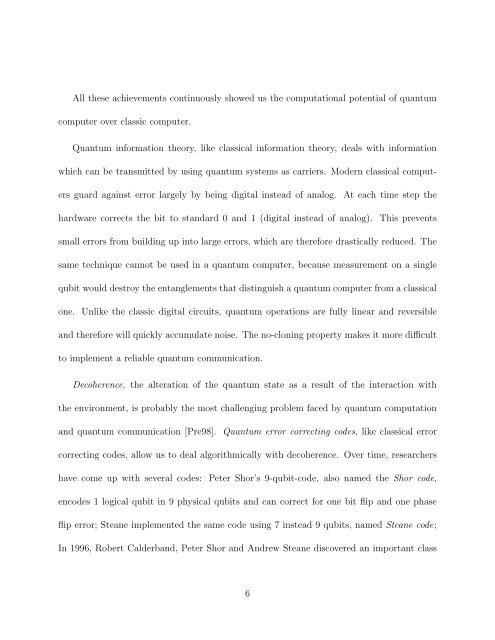t b a b a
t b a b a
t b a b a
You also want an ePaper? Increase the reach of your titles
YUMPU automatically turns print PDFs into web optimized ePapers that Google loves.
All these achievements continuously showed us the computational potential of quantum<br />
computer over classic computer.<br />
Quantum information theory, like classical information theory, deals with information<br />
which can be transmitted by using quantum systems as carriers. Modern classical comput-<br />
ers guard against error largely by being digital instead of analog. At each time step the<br />
hardware corrects the bit to standard 0 and 1 (digital instead of analog). This prevents<br />
small errors from building up into large errors, which are therefore drastically reduced. The<br />
same technique cannot be used in a quantum computer, because measurement on a single<br />
qubit would destroy the entanglements that distinguish a quantum computer from a classical<br />
one. Unlike the classic digital circuits, quantum operations are fully linear and reversible<br />
and therefore will quickly accumulate noise. The no-cloning property makes it more difficult<br />
to implement a reliable quantum communication.<br />
Decoherence, the alteration of the quantum state as a result of the interaction with<br />
the environment, is probably the most challenging problem faced by quantum computation<br />
and quantum communication [Pre98]. Quantum error correcting codes, like classical error<br />
correcting codes, allow us to deal algorithmically with decoherence. Over time, researchers<br />
have come up with several codes: Peter Shor’s 9-qubit-code, also named the Shor code,<br />
encodes 1 logical qubit in 9 physical qubits and can correct for one bit flip and one phase<br />
flip error; Steane implemented the same code using 7 instead 9 qubits, named Steane code;<br />
In 1996, Robert Calderband, Peter Shor and Andrew Steane discovered an important class<br />
6

















